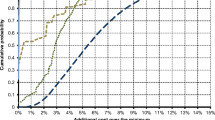Abstract
A methodology to identify the partial blockages in a simple pipeline using genetic algorithms for non-harmonic flows is presented in this paper. A sinusoidal flow generated by the periodic on-and-off operation of a valve at the outlet is investigated in the time domain and it is observed that pressure variation at the valve is influenced by the opening size of blockage and its location. In this technique, the unsteady (steady oscillatory) pressure time series at only one location is required to identify two blockages. In the proposed methodology, the solution of the governing hyperbolic PDEs of pipe flow is obtained using the method of characteristics. For any piping system similar to the hypothetical pipe system used in the simulations, generalized best amplitude and best frequency of the valve operation are determined, which give maximum deviation in pressure responses for a specific blockage at different locations for a given constant-head reservoir. The generalized best amplitude and best frequency of the valve operation are also obtained for two blockages. Accuracy of the proposed methodology in identifying blockages in a hypothetical simple pipe system with increased noise in the simulated measurements is studied. A non-dimensional variable is proposed to determine whether the proposed methodology is applicable to isolate partial blockages in a piping system. Finally, the proposed methodology is experimentally validated on a laboratory piping system for a single blockage and two blockages.









Similar content being viewed by others
References
Qunli W 1994 Reconstruction of blockage in a duct from single spectrum. Appl. Acoust. 41(3): 229–236
Scott S L and Satterwhitee L A 1998 Evaluation of the back pressure technique for blockage detection in gas flowlines. J. Energy Resour. Technol. 120: 27–31
Scott S L and Yi J 1999 Flow testing methods to detect and characterize partial blockages in looped subsea flowlines. J. Energy Resour. Technol. 121: 154–160
Adewumi M A, Eltohami E S and Ahmed W H 2000 Pressure transients across constrictions. J. Energy Resour. Technol. 122: 34–41
Wang X J, Lambert M F and Simpson A R 2005 Detection and location of a partial blockage in pipeline systems using damping of fluid transients. J. Water Resour. Plan. Manag. 131(3): 244–249
Brunone B, Ferrante M and Meniconi S 2008 Portable pressure wave-maker for leak detection and pipe system characterization. J. Am. Water Works Assoc. 100(4): 108–116
Lee P J, Vitkovsky J P, Lambert M F, Simpson A R and Liggett J A 2005 Frequency domain analysis for detecting pipeline leaks. J. Hydraul. Eng. 131(7): 596–604
Chaudhry M H 2013 Applied hydraulic transients, 3rd edn. New York: Springer
[9] Liou C P 1998 Pipelines leak detection by impulse response extraction. J. Fluids Eng. 120: 833–838
De Salis M H F and Oldham D J 1999 Determination of the blockage area function of a finite duct from a single pressure response measurement. J. Sound Vib. 221(1): 180–186
Ferrante M and Brunone B 2003 Pipe system diagnosis and leak detection by unsteady-state tests: harmonic analysis. Adv. Water Resour. 26: 95–105
Mohapatra P K, Chaudhry M H, Kassem A A and Moloo J 2006 Detection of partial blockage in single pipelines. J. Hydraul. Eng. 132(2): 200–206
Covas D, Ramos H and de Almeida A B 2005 Standing wave difference method for leak detection in pipeline systems. J. Hydraul. Eng. 131(12): 1106–1116
Lee P J, Vítkovský J P, Lambert M F, Simpson A R and Liggett J A 2005 Leak location using the pattern of the frequency response diagram in pipelines: a numerical study. J. Sound Vib. 284(3): 1051–1073
Mohapatra P K, Chaudhry M H, Kassem A A and Moloo J 2006 Detection of partial blockages in a branched piping system by the frequency response method. J. Fluids Eng. 128(5): 1106–1114
Brunone B and Ferrante M 2001 Detecting leaks in pressurized pipes by means of transients. J. Hydraul. Res. 39(5): 539–547
Pudar R S and Liggett J A 1992 Leaks in pipe networks ASCE J. Hydraul. Eng. 118(7): 1031–1046
Liggett J A and Chen L C 1994 Inverse transient analysis in pipe networks. ASCE J. Hydraul. Eng. 120(8): 934–955
Zhang Y, Zheng Y, Yang C, Zhu Y and Zhang X 2015 System design and optimization study of axial flow turbine applied in an overtopping wave energy convertor. Sadhana 40(8): 2313–2331
Vitkovsy J P, Simpson A R and Lambert M F 2000 Leak detection and calibration using transients and genetic algorithms. J. Water Resour. Plan. Manag. 126(4): 262–265
Sattar A M, Chaudhry M H and Kassem A A 2008 Partial blockage detection in pipelines by frequency response method. J. Hydraul. Eng. 134(1): 76–89
Goldberg D E 1989 Genetic algorithms in search, optimization and machine learning. Boston, MA: Kluwer Academic
Sangeetha S and Jeevanathan S 2015 Influence of crossover methods used by genetic algorithm-based heuristic to solve the selective harmonic equations (SHE) in multi-level voltage source inverter. Sadhana 40(8): 2389–2410
MATLAB and Statistics Toolbox Release 2012 Natick, Massachusetts, United States: The MathWorks Inc
Author information
Authors and Affiliations
Corresponding author
Rights and permissions
About this article
Cite this article
Hanmaiahgari, P.R., Elkholy, M. & Riahi-Nezhad, C.K. Identification of partial blockages in pipelines using genetic algorithms. Sādhanā 42, 1543–1556 (2017). https://doi.org/10.1007/s12046-017-0707-8
Received:
Revised:
Accepted:
Published:
Issue Date:
DOI: https://doi.org/10.1007/s12046-017-0707-8




